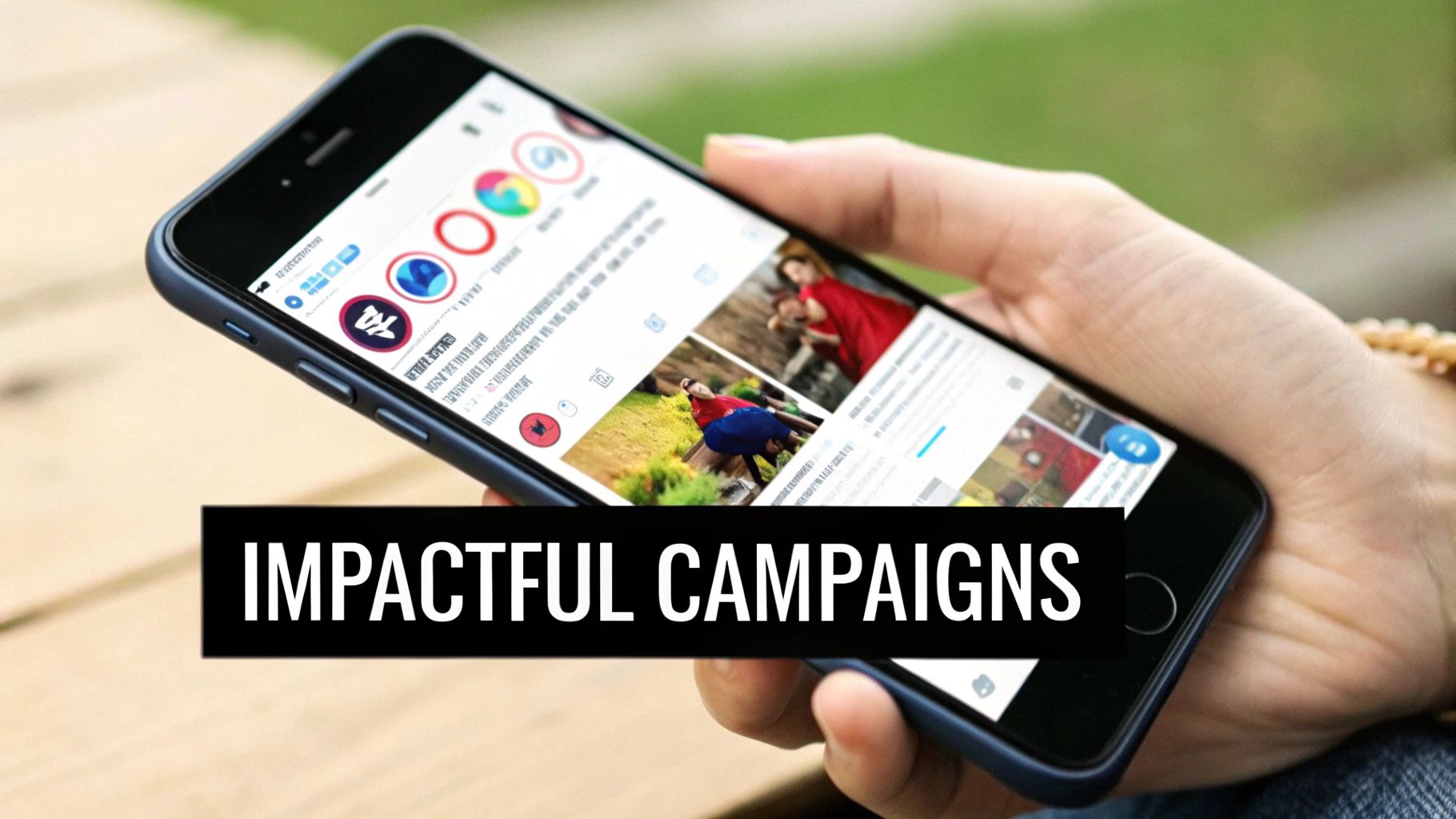
Writing Copy for Social Media in 2024

Gone are the days of relying only on catchy taglines for social media success. Today's brands win by using real data and audience research to craft messages that truly connect with their followers. Smart copywriting combines creative storytelling with strategic planning to build engaged communities.
What Works on Different Platforms
Choosing the right platform makes a huge difference in social media success. Recent stats show a major shift – only 47% of marketers now see Facebook as their top platform, down from 67% in 2018. Many are expanding to reach audiences across multiple networks. For example, 67% of marketers plan to focus more on YouTube in the coming year, seeing strong results from organic video content and viewer engagement. Learn more about these trends.
Creating Content People Want to Share
The best social posts tap into basic human psychology – they stir emotions, feel relatable, and build trust through social proof. Research shows that customers who feel an emotional connection have a 306% higher lifetime value compared to others. This highlights why it's worth taking time to craft messages that resonate on a personal level.
Writing formulas like Problem-Agitate-Solution (PAS) help create posts that grab attention. This approach works by: 1) pointing out a common challenge, 2) discussing why it matters, and 3) offering a clear fix. When social feeds move fast, these proven techniques help your content stand out and encourage action.
Real Results from Smart Copy
Here are some real examples of copywriting that delivered:
- Brand X used PAS in a campaign about customer pain points, leading to 25% more engagement
- Company Y focused on emotional storytelling that boosted interactions by 40%
These cases show how small changes in writing approach can drive big improvements. By learning what makes each platform tick and understanding what motivates your audience, you can create social content that builds lasting connections and gets measurable results.
Creating Visual Content That Stops The Scroll

Getting noticed on social media requires eye-catching content that makes people pause their scrolling. Your visuals serve as the first point of contact with potential followers – they either grab attention or get lost in the feed.
The Psychology of Visual Appeal
Great social media copy works hand-in-hand with strong visuals. A well-chosen image or video clip can instantly spark emotions and tell your brand's story. But visuals alone aren't enough – they need to be paired with copy that strengthens their impact.
Crafting Captions That Convert
Your captions should do more than just describe what's in the image. Use them to provide context, add personality, or include a clear call-to-action. For instance, if you're featuring a product, let the image showcase its design while your caption highlights key benefits. This combo turns a basic post into an engaging sales message.
Smart captions also help build community. Ask followers questions, encourage discussion, and create conversations around your brand.
Thumbnails: The Gateway to Your Content
Think of thumbnails as movie posters for your content. Whether on YouTube or in social media link previews, an attention-grabbing thumbnail can make the difference between someone clicking or scrolling past. Make sure it clearly represents what viewers will get when they engage.
Visual Storytelling for Brand Cohesion
A clear visual style helps people recognize and trust your brand. Keep your colors, fonts, and image style consistent across platforms. This builds a memorable brand identity that stands out from competitors.
The numbers back up the power of visuals in social media. Facebook posts with images get 53% more likes, 104% more comments, and 84% more click-throughs than text-only posts. Additionally, 96% of consumers watch videos to learn about products, while 64% of marketers are increasing their short-form video content. See more stats here. By combining strong visuals with persuasive writing, you can create content that truly captures attention and drives results.
Platform-Specific Writing Strategies That Convert
Social media copywriting requires understanding each platform's unique voice and style. The message that works brilliantly on Twitter may not resonate on Instagram. Success comes from adapting your content to fit each channel while still keeping your core message intact.
Mastering the Nuances of Each Network
Every social platform speaks its own language and attracts different audiences. Conciseness matters most on Twitter – you need to make your point quickly and memorably within the character limit. Instagram is built around visual stories, so captions need to enhance and complement your images. Facebook gives you room for longer posts and community discussions. Getting these differences right can significantly boost your results.
Format-Specific Formulas for Engaging Content
Different platforms need different content approaches. Quick questions work great for Twitter engagement, while Instagram rewards deeper storytelling through captions. On Facebook, try using the Problem-Agitate-Solution (PAS) method – describe a common challenge your audience faces, highlight why it's frustrating, then show how your product helps solve it. Want to learn more? Check out How to master the nuances of micro-influencers.
Tailoring Your Brand Voice to Each Platform
Keep your core brand voice steady while adjusting the tone for each platform. Think of it as speaking the same message in different ways to different groups. Use professional language on LinkedIn, get more casual on Instagram, and have fun on TikTok – but always stay true to your brand's personality.
Examples of Platform-Optimized Content
Here's how to adapt content across platforms: For Twitter, try a quick hook: "Need help with social scheduling? Get our top time-saving tips!" On Instagram, tell a story: "Remember the chaos of manual posting? Our scheduling tool lets you plan weeks ahead, giving you more time to connect with followers." Facebook posts can use the Before-After-Bridge (BAB) technique – show life before your solution, paint the picture of success after, and position your product as the path between.
Practical Tips for Crafting Platform-Specific Copy
- Study your audience: Learn how they interact differently across platforms
- Watch top performers: Note which posts get the most engagement
- Test content types: Try various lengths, styles and storytelling approaches
- Use native features: Take full advantage of polls, hashtags and platform tools
Following these targeted strategies helps you connect better with followers and turn them into customers on each platform.
Engineering Engagement Through Strategic Copy

Great social media copywriting is more than posting content – it's about creating messages that connect with your audience and spark real conversations. The key is understanding what motivates people to engage, share, and take action.
Understanding the Psychology of Sharing
People share on social media to build connections, express themselves, and help others with useful information. Content that triggers emotions, highlights social proof, or provides practical value tends to perform best. For example, real customer testimonials build trust and encourage others to try your offerings.
Crafting Messages That Inspire Authentic Conversation
Smart brands know social media success comes from two-way dialogue. This means asking thoughtful questions, responding to comments promptly, and creating content that sparks discussion. Using a friendly, conversational tone helps make your brand more approachable and builds community.
Elements of High-Engagement Copy
Several key elements reliably boost social media engagement. Eye-catching headlines are crucial for stopping the scroll. Your headlines should clearly highlight the value and pique curiosity. Strong calls-to-action that give clear direction (like "Join Now" or "Get Started") help drive results. Most importantly, your message needs to speak directly to your audience's specific interests and needs. The Problem-Agitate-Solution (PAS) framework works well for addressing pain points.
Crafting Compelling Headlines
To write scroll-stopping headlines, you need to know what grabs your audience's attention. Numbers and questions often work well. For instance, "5 Tips for Writing Engaging Social Media Copy" performs better than vague headlines like "Social Media Tips." Creating urgency or exclusivity can also boost clicks.
Calls-to-Action That Convert
Keep your calls-to-action brief and impactful. Active verbs like "Get," "Start," or "Join" motivate quick response. Making CTAs stand out visually with buttons or bold text improves results. Your audience should never wonder what step to take next.
Messaging That Resonates
The most effective social media copy speaks to your audience's core motivations. When you deeply understand their needs and challenges, you can create messages that truly connect and build lasting relationships. This turns social media from basic broadcasting into a powerful tool for growing real engagement and business results.
Measuring And Optimizing Copy Performance
Getting good results from social media copy isn't just luck – it requires tracking key metrics and making improvements based on real data. Let's look at how to make your copy work harder.
Key Metrics for Social Media Copywriting
The right metrics help you understand what's connecting with your audience. Focus on metrics that match your goals:
- Engagement: Track likes, comments, shares, and saves to see if your copy resonates
- Reach: Monitor how many unique users see your content to assess visibility
- Website Clicks: Measure link clicks if driving web traffic is your goal
- Conversions: Track sales, sign-ups or downloads to gauge bottom-line impact
A/B Testing: Refining Your Approach
A/B testing helps optimize your copy by testing two versions with different audiences. Create version A and B with small differences – like alternate headlines or calls-to-action. See which performs better to find what works best. This takes the guesswork out of copywriting.
Using Data to Drive Continuous Improvement
Study your metrics and test results to learn what your audience responds to. Use these insights to keep refining your copy approach over time. As you gather more data, your campaigns will get increasingly effective. Related: How to master client acquisition.
Analyzing Successful Optimization Case Studies
Look at how successful brands measure and improve their copy. Study their techniques and adapt the most relevant approaches for your own social media strategy. Real examples provide practical ideas you can use.
Tools for Data-Driven Copywriting
Analytics platforms track key engagement and reach metrics. A/B testing tools make it easy to run and analyze copy tests. Using the right tools helps you make smart decisions based on real performance data rather than hunches.
Building a Framework for Long-Term Success
Create a system for ongoing optimization that includes:
- Regular metric monitoring
- A/B testing copy variations
- Analyzing results
- Making data-driven improvements
This structured approach helps you consistently create high-performing social content that builds your brand, engages followers, and drives results over time.
Implementation Blueprint For Social Media Success

Creating effective social media copy needs more than just writing skills – it requires a clear plan and system. Here's a practical guide to help you get real results. For more insights, check out: How to master a winning social media content strategy.
Building Your Content Calendar
A solid content calendar helps you post consistently. Plan your posts ahead of time and mix up different types of content to keep things interesting. Focus on quality over quantity.
- Pick Your Posting Schedule: Choose how often you'll post on each platform
- Create Content Themes: Group related posts into campaigns
- Plan in Advance: Use scheduling tools to maintain regular posting
Defining Your Brand Voice
Your brand voice shows your personality on social media. Keep it consistent but adjust the tone slightly for different platforms. This helps people instantly recognize your content.
- Create Clear Guidelines: Write down your brand's tone and style rules
- Customize for Each Platform: Keep core voice while fitting each channel
- Show Real Examples: Include samples of posts that match your voice
Processes for Consistent Content Creation
Good content needs good systems. Set up clear steps for brainstorming ideas, writing posts, reviewing them, and scheduling. This keeps quality high and makes the work smoother.
- Regular Idea Sessions: Meet with your team to generate fresh content ideas
- Clear Writing Process: Define specific steps from draft to publish
- Quality Checklist: Use a checklist to maintain standards
Scaling Your Social Media Copywriting
As you grow, you'll need ways to create more content efficiently. Use tools and resources that help maintain quality while increasing output.
- Create Post Templates: Make templates for common post types
- Reuse Good Content: Adapt existing posts for different platforms
- Get Extra Help: Hire freelancers when needed for specific tasks
Ready-to-Use Templates and Checklists
Having the right tools makes consistent social media much easier. Here are key resources to help you succeed:
| Resource | Purpose |
|---|---|
| Content Calendar | Plan and schedule your posts |
| Voice Guidelines | Document your brand's style |
| Quality Checklist | Ensure posts meet standards |
Start using this blueprint today to build a strong social media presence that gets results. Small, consistent steps lead to big improvements over time.
Want expert help with your social media strategy? Visit Jason Yormark to learn how we can help grow your brand.


Leave a Reply